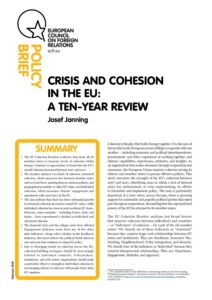The EU Cohesion Monitor evaluates data from all 28 member states to measure levels of cohesion within Europe. Contrary to expectations, it found that the EU’s overall cohesion increased between 2007 and 2017.
The monitor analyses two kinds of cohesion: structural cohesion, which measures ties between member states such as trade flows, participation in common policies, and geographical proximity to other EU states; and individual cohesion, which measures citizens’ engagement and experiences with, and views of, the EU.
The data indicate that there has been substantial growth in structural cohesion in eastern central EU states, while individual cohesion has risen in most northern EU states. However, some countries – including France, Italy, and Spain – have experienced a decline in individual and structural cohesion.
The financial crisis and the refugee crisis have affected Engagement indicator more than any of the other nine indicators. Along with a decline in the Resilience indicator, this trend reflects the political divide between east and west that continues to shape EU policy.
Due to diverging trends in cohesion across the EU, cohesion-building strategies should be increasingly tailored to individual countries. Policymakers, institutions, and civil society organisations should make a particular effort to strengthen individual cohesion by encouraging citizens to interact with people from other EU countries. POLICY BRIEF


